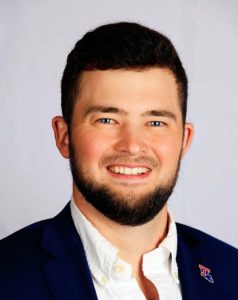NEWS
A Life-Saving Difference
As Christian Brown did, you can make a life-saving difference by donating just a few moments and a mouth swab in Wednesday’s on-campus drive to help those fighting blood cancer diseases.
Wednesday (Nov. 7) in the Louisiana Tech Plaza, Tech’s Department of Health Informatics and Information Management (HIIM) is sponsoring a bone marrow drive from 10 a.m. to 2 p.m. Your donation is quick and more simple than you might imagine — but also more important that you might have considered.
 Brown, a Tech B.S. in management graduate from DeRidder pursuing his MBA in the College of Business, was walking across campus last spring just a few days before his undergraduate commencement when he was asked to donate a simple mouth swab, the first step in a test that he was told could potentially save the life of someone with blood cancer.
Brown, a Tech B.S. in management graduate from DeRidder pursuing his MBA in the College of Business, was walking across campus last spring just a few days before his undergraduate commencement when he was asked to donate a simple mouth swab, the first step in a test that he was told could potentially save the life of someone with blood cancer.
“I’ve grown up giving back to the community with the amount of organizations I have been a part of, like Boy Scouts and MedCamps,” he said. “I wanted to support this cause, because I would want someone to do the same for me.”
Brown proved to be a match for someone with blood cancer. Since then, he’s donated—and grateful he did.
“I feel awesome that I have a chance to potentially save someone’s life,” he said. “It’s a very eye-opening experience to potentially save someone that you don’t even know.”
His girlfriend, Tech HIIM junior Elizabeth “Liz” Booth, “supported me through every step of the process,” he said. “It didn’t take too much convincing to do this. The process went super smooth with the amount of people that helped along the way, especially with the support of Liz.”
Due to medical privacy laws, he can’t say where he traveled to make the donation, but it was paid for and took five hours “to complete the whole process,” Brown said. “For the stem cell donation, you get stem cell boosters (shots) for the process leading up to the donation. This is only because at the time of donation, you must have stem cells whenever the donation is completed.
“Donating stem cells is the same process as donating blood,” said Brown, 22. “It’s a very simple process. You have one tube where they draw the blood out to filter it and then another tube going into the other arm and back into your body.”
The drive is through DKMS, an international non-profit bone marrow and blood stem cell registry dedicated to the fight against blood cancer and blood disorders by creating awareness, recruiting bone marrow donors to provide a second chance at life, raising funds to match donor registration costs, supporting the improvement of therapies through research, and supporting patients from Day One of their diagnoses.
“People sign up by swabbing the inside of their cheeks, then we send the swabs to DKMS,” said associate professor Jan Fuller, HIM department head at Tech. “They take the samples, analyze them, and put the results into a registry, which doctors can use to determine if there is a match for their patient. The transplants can be used to treat leukemia, lymphoma, and other types of blood diseases.”
“It all starts off with doing the mouth swab,” Brown said. “You then have to be matched with a patient. Most people never get matched or get matched years down the road; in my case, it took only a few months.
“Once matched,” he said, “people will reach out to you to explain the process of donating and how it works. You have to make the decision if you want to donate or not. When you are ready to donate, you will donate either bone marrow or stem cells; the chance is 90 percent you’ll donate stem cells. It’s a super simple process to donate, and it could potentially save someone’s life.”